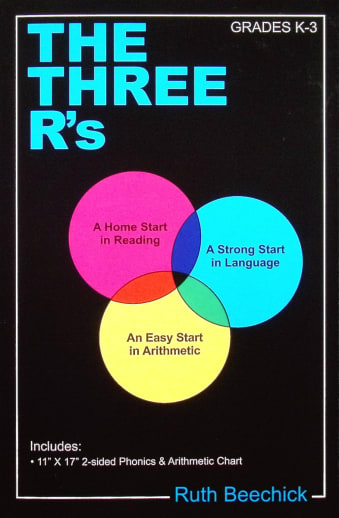A set of three well-written, helpful books by Dr. Beechick. A Home Start in Reading is chock-full of no-nonsense advice for teaching your child to read. Dr. Beechick includes a phonics system, chart, advice on dealing with those "messy" phonics problems and sight words, what to do "after" phonics, and suggestions for teaching spelling. A wealth of hints and helps packed in 32 pages. In A Strong Start in Language, Dr. Beechick explains an easy-to-use, natural method for teaching a child to write. Sample lessons are provided as a starting point. Discover Dr. Beechick's "powerful, real-life, home method" for teaching your child to go beyond mere memorization to thinking mathematically in An Easy Start in Arithmetic. Includes teaching ideas, games and activities.
Three-R's Series (Reading, Language, Math)
SKU
000846
ISBN
9780880620741
Grade K-3
These icons are designed to help you quickly understand and learn important information about our products.
Teaching Method
Traditional
Teacher-centered curriculum commonly used in classrooms that may include a text, teacher manual, tests, etc.
Charlotte Mason
A methodology based on the work of a 19th century educator who maintained that children learn best from literature (Living Books), not textbooks.
Classical
A methodology based on the Latin Trivium (three stages of learning), including the grammar stage (memorization and facts), logic stage (critical thinking), and rhetoric stage (developing/defending ideas).
Unit Study
A thematic or topical approach centered around one topic that integrates multiple subject areas.
Montessori (Discovery)
A methodology based on the work of a 20th century educator that emphasizes student and sensory-driven discovery learning and real-life applications.
Other
Other methodologies
Religious Content
Secular
Contains content contrary to common Christian beliefs (i.e. evolution).
Neutral
Avoids religious or theoretical topics or presents multiple viewpoints without preference.
Christian/Religious
Faith-based or including instructional religious content.
Learning Modality
Auditory
Learns through listening, talking out loud or reading out loud.
Visual
Learns through seeing, prefers written instructions and visual materials.
Kinesthetic/Tactile (Hands-On)
Learns through moving, doing and touching.
Multi-Sensory
Curriculum that employ a variety of activities/components.
Presentation
Sequential
Curriculum progresses through well-defined learning objectives. Emphasizes mastery before moving to the next topic.
Spiral
Topics and concepts are repeated from level to level, adding more depth at each pass and connecting with review.
Conceptual/Topical
Focus is on the “why,” often with a unifying concept as well as specific skills; coverage may be broader.
Teacher Involvement
Low Teacher Involvement
Student-led materials; parent acts as a facilitator.
Medium Teacher Involvement
A mix of teacher-led time and independent student work.
High Teacher Involvement
Teacher-led lessons; may utilize discussions, hands-on activities and working together.
Additional Materials Required
No other materials needed
Everything you need is included.
Other Materials Required
There are additional required resources that are a separate purchase.
Other Materials Optional
There are additional resources mentioned or recommended but are not absolutely necessary.
Consumable
Consumable
Designed to be written in; not reusable.
Non-Consumable
Not designed to be written in; reusable.
Our Price
$12.00 $12.00 $9.95
Rainbow Savings: $2.05
Description
Publisher's Description of Three-R's Series (Reading, Language, Math)
This compiles three popular "get-started" resources from educator Ruth Beechick: "A Home Start in Reading," "A Strong Start in Language," and "An Easy Start in Arithmetic."
Learn how to take the mystery out of teaching the early grades with this practical, down-to-earth guidebook. The book is divided into three sections that are tabbed for easy reference. The READING section tells how and when to begin phonics, and how to develop comprehension skills. The LANGUAGE section shows how to develop written language skills naturally, in the same way children learn oral language. The ARITHMETIC section explains how to teach understanding of math concepts, and not just memorization of facts.
Details
| Product Format: | Softcover Book |
|---|---|
| Grades: | K-3 |
| Brand: | Mott Media |
| Author: | Ruth Beechick |
| ISBN: | 9780880620741 |
| Length in Inches: | 8.5 |
| Width in Inches: | 5.5 |
| Height in Inches: | 0.25 |
| Weight in Pounds: | 0.35 |
| Edition: | Illustrated |
| Pages: | 120 |
| Publication Date: | 5/6/2013 |
Videos
Reviews

